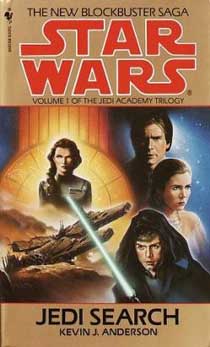Kevin J. Anderson contributed many of the most essential post-Endor elements to the EU, going forward with the same ideas George Lucas would go “backward” with. Whereas Lucas explored the old Jedi Order and the early Death Star designs in the prequels, Anderson has Luke start up a new Jedi Order and reveals there’s another Death Star prototype out there in “Jedi Search” (1994), the first book of the “Jedi Academy Trilogy.”
Anderson gets a fair amount of guff because — let’s face it — he’s not as good of a writer as his “Star Wars” contemporaries like Zahn, Stackpole and Crispin. His books have shallower character arcs and connect-the-dots plotting; they are a bit too predictable. However, even though I still found it overwritten at times, I generally enjoyed my re-reading of “Jedi Search.”
Nineteen years after its publication, the continuity holds up beautifully; although Anderson unfortunately snubs the Marvel comics (something he’d also do in the “Star Wars Encyclopedia”), he regularly references events in the Thrawn trilogy and the “Dark Empire” comics (He doesn’t reference the “X-Wing” stories because they weren’t written yet, but he doesn’t contradict them either). So when Luke thinks about what he’s learned in the Force, he thinks back to not only Ben and Yoda, but also C’baoth and the reborn Emperor. In setting up his academy on Yavin IV, he’s armed not only with those teachings, but also with the Holocron he acquired in “Dark Empire.” And among his students is Kam Solusar from “Dark Empire II” and some witches of Dathomir from “The Courtship of Princess Leia.” (It would’ve been neat to see Luke at least check in with Kiro from the Marvel Comics.)
Having just re-read “I, Jedi,” I wanted to delve into Anderson’s writing of those same events in this trilogy. But the Exar Kun plot actually waits until the next book. In “Jedi Search,” Luke — essentially having his droids perform a Google search — tracks down Force-sensitives Gantoris and Streen. Whereas Qui-Gon tests Anakin’s blood for midi-chlorians in “Episode I,” Luke uses a scanning device and a brain meld technique.
Anderson nicely shows Leia’s frustration with juggling motherhood and diplomatic duties, while also feeling guilty that she isn’t working on her Jedi skills. Although he dismisses the Marvel comics out of hand, Anderson inadvertently continues Luke’s and Leia’s character arcs from the end of that series.
Meanwhile, Han and Chewie get captured and thrown in the spice mines of Kessel, so we finally visit the potato-shaped, thin-atmosphere planet mentioned twice in “A New Hope.” (Russ Manning portrayed a lush, beautiful Kessel in his comic strip, but that’s considered non-canon.) Young spice-mine prisoner Kyp Durron is the equivalent of Luke in a yarn that riffs on the Death Star escape plot. While the horrors of the spice mines are evocative, Anderson doesn’t have quite the handle on Han and Chewie that Crispin or Daley do. And I find it weird that the Han-Kyp friendship petered out in later EU novels, because Anderson lays the groundwork here. (Instead, Kyp would become just a talking head in Jedi Master discussions.)

Anderson’s books read like laced-together short stories, for better or worse. In the hokiest segment, we get the moment-by-moment details of a blob race as Lando investigates a potential Jedi. Although Anderson once said that he writes all his books the same way — whether categorized as “adult” or “young adult” — “Jedi Search” is thankfully a bit richer than his “Young Jedi Knights” series. Kyp is a strong new character, and I also am intrigued by willowy scientist Qwi Xux, the naive Imperial superweapon designer who is horrified to learn what her designs were actually used for.
Emerging from the Maw cluster after a decade of not knowing the Emperor was defeated, Admiral Daala is a mediocre villain (She’d continue to play a major role in the EU down the road). Her tactical reliance on superweapons — both the Sun Crusher AND a Death Star prototype! — doesn’t make for compelling reading, especially the second time through.
I remember being more enamored by “Jedi Search” — the first mass-market paperback of the Bantam license — when it came out 19 years ago. Even then, I knew it wasn’t up to Zahn’s standards, but I loved finding out what my favorite characters were up to as the New Republic was being formed. On this more critical re-read, I braced myself for a slog since Anderson’s work has been so maligned in the years since, but it wasn’t as bad as I feared. It’s not a masterpiece, but at least it feels like “Star Wars.”
Comments
![]() The Jedi Academy trilogy is probably the best of Kevin J. Anderson’s works for the EU after Tales of the Jedi. Jedi Search is a good, though not great, adventure. I agree with you about how Kiro would be a good add to the academy students, and of course, Daala is pure shit, but the concept behind her was later better used in Isard!# Posted By Eric | 9/10/13 10:48 PM
The Jedi Academy trilogy is probably the best of Kevin J. Anderson’s works for the EU after Tales of the Jedi. Jedi Search is a good, though not great, adventure. I agree with you about how Kiro would be a good add to the academy students, and of course, Daala is pure shit, but the concept behind her was later better used in Isard!# Posted By Eric | 9/10/13 10:48 PM
![]() Also I forgot to say how Anderson’s obsession with super galactic weapons bothers me. Back in Dark Empire we already had the world devastators and the galactic gun, Anderson continues that story here and brings the Death Star prototype AND the Sun Crusher. Damn he even creates a new super weapon in Darksaber!# Posted By Eric | 9/10/13 11:04 PM
Also I forgot to say how Anderson’s obsession with super galactic weapons bothers me. Back in Dark Empire we already had the world devastators and the galactic gun, Anderson continues that story here and brings the Death Star prototype AND the Sun Crusher. Damn he even creates a new super weapon in Darksaber!# Posted By Eric | 9/10/13 11:04 PM
![]() I think Anderson is pretty great on environmental descriptions. I get a good sense of what Kessel is like, for example. But he’s pretty awful in terms of military tactics and character motivations. Daala, from the get-go, is a pathetic villain. Luckily, as the trilogy goes forward, we get the more compelling villains of Kyp and Exar Kun’s ghost. Unfortunately, we still have to deal with Daala, though. I also notice — compared to the greats like Zahn, Stackpole and Crispin — more plot points in Anderson’s work that go largely unexplained. For example, the Solo Jedi children are hidden on a secret planet. But why? How did Han and Leia come to this decision to hide their children? And why are they not hidden with their own children, instead leaving them with a babysitter? It seems that at least Han could be with them, since he’s not as essential to the New Republic as Leia is. And then what makes them change their mind and have the two oldest move in with them on Coruscant, but not the third? As far as I can tell, the parents’ reasoning is not delved into at all.# Posted By John Hansen | 9/11/13 2:25 AM
I think Anderson is pretty great on environmental descriptions. I get a good sense of what Kessel is like, for example. But he’s pretty awful in terms of military tactics and character motivations. Daala, from the get-go, is a pathetic villain. Luckily, as the trilogy goes forward, we get the more compelling villains of Kyp and Exar Kun’s ghost. Unfortunately, we still have to deal with Daala, though. I also notice — compared to the greats like Zahn, Stackpole and Crispin — more plot points in Anderson’s work that go largely unexplained. For example, the Solo Jedi children are hidden on a secret planet. But why? How did Han and Leia come to this decision to hide their children? And why are they not hidden with their own children, instead leaving them with a babysitter? It seems that at least Han could be with them, since he’s not as essential to the New Republic as Leia is. And then what makes them change their mind and have the two oldest move in with them on Coruscant, but not the third? As far as I can tell, the parents’ reasoning is not delved into at all.# Posted By John Hansen | 9/11/13 2:25 AM

